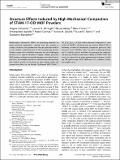Files in this item
Structure effects induced by high mechanical compaction of STAM-17-OEt MOF powders
Item metadata
| dc.contributor.author | Terracina, Angela | |
| dc.contributor.author | McHugh, Lauren N. | |
| dc.contributor.author | Mazaj, Matjaz | |
| dc.contributor.author | Vrtovec, Nika | |
| dc.contributor.author | Agnello, Simonpietro | |
| dc.contributor.author | Cannas, Marco | |
| dc.contributor.author | Gelardi, Franco | |
| dc.contributor.author | Morris, Russell E. | |
| dc.contributor.author | Buscarino, Gianpiero | |
| dc.date.accessioned | 2021-06-29T10:30:03Z | |
| dc.date.available | 2021-06-29T10:30:03Z | |
| dc.date.issued | 2021-06-22 | |
| dc.identifier | 274375085 | |
| dc.identifier | 6698f521-e8c2-4aae-bd97-e78b63f238bc | |
| dc.identifier | 000661503600001 | |
| dc.identifier | 85107858847 | |
| dc.identifier.citation | Terracina , A , McHugh , L N , Mazaj , M , Vrtovec , N , Agnello , S , Cannas , M , Gelardi , F , Morris , R E & Buscarino , G 2021 , ' Structure effects induced by high mechanical compaction of STAM-17-OEt MOF powders ' , European Journal of Inorganic Chemistry , vol. 2021 , no. 24 , pp. 2334-2342 . https://doi.org/10.1002/ejic.202100137 | en |
| dc.identifier.issn | 1434-1948 | |
| dc.identifier.other | RIS: urn:E0F573E33AFE1B53669D38FD263EFD44 | |
| dc.identifier.other | ORCID: /0000-0001-7809-0315/work/96489436 | |
| dc.identifier.uri | https://hdl.handle.net/10023/23439 | |
| dc.description | Financial support by PJ-RIC-FFABR_2017 and the EPSRC grant EPSRC industrial CASE award (grant EP/N50936X/1) are acknowledged. The research programme Nanoporous materials (P1-0021) financially supported by Slovenian Research Agency (ARRS) is acknowledged as well. | en |
| dc.description.abstract | Metal-organic frameworks (MOFs) are promising materials for many potential applications, spacing from gas storage to catalysis. However, the powder form of which they are generally made is not suitable, mainly because of the low packing density. Powder compaction is therefore necessary, but also challenging because of their typical mechanical fragility. Indeed, generally, they undergo irreversibly damages upon densification processes, for example partially or totally loosing microporosity and catalytic activity. In this work, we deeply study the compaction effects on the flexible Cu(II)-based MOF STAM-17-OEt (Cu(C10O5H8)1.6 H2O), whose chemical composition is close to that of HKUST-1, obtaining that it is, by contrast, extremely suitable for mechanical compaction processes with pressures up to 200 MPa, which increase its packing density, its catalytic activity, and preserve porosity, flexibility and water stability, characteristics of STAM-17-OEt. The results are supported by many experimental techniques including EPR spectroscopy, PXRD diffraction, CO2 isotherms studies and catalytic tests. | |
| dc.format.extent | 7349365 | |
| dc.language.iso | eng | |
| dc.relation.ispartof | European Journal of Inorganic Chemistry | en |
| dc.subject | EPR spectroscopy | en |
| dc.subject | Flexible MOFs | en |
| dc.subject | Metal-organic frameworks | en |
| dc.subject | MOF Tableting | en |
| dc.subject | MOF stability | en |
| dc.subject | QD Chemistry | en |
| dc.subject | 3rd-DAS | en |
| dc.subject.lcc | QD | en |
| dc.title | Structure effects induced by high mechanical compaction of STAM-17-OEt MOF powders | en |
| dc.type | Journal article | en |
| dc.contributor.institution | University of St Andrews. School of Chemistry | en |
| dc.contributor.institution | University of St Andrews. EaSTCHEM | en |
| dc.identifier.doi | 10.1002/ejic.202100137 | |
| dc.description.status | Peer reviewed | en |
| dc.identifier.url | https://chemistry-europe.onlinelibrary.wiley.com/doi/10.1002/ejic.202100137#support-information-section | en |
This item appears in the following Collection(s)
Items in the St Andrews Research Repository are protected by copyright, with all rights reserved, unless otherwise indicated.

